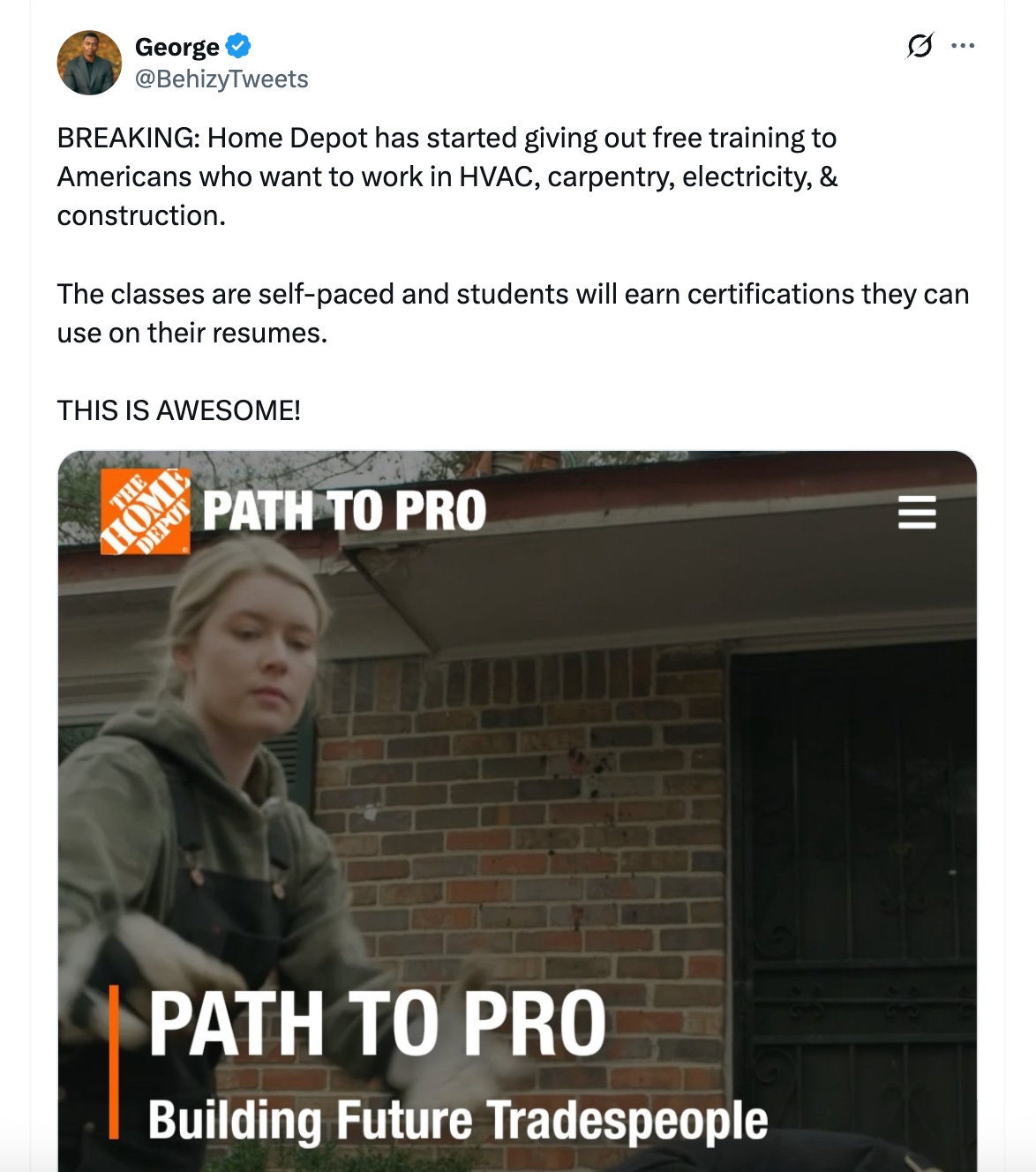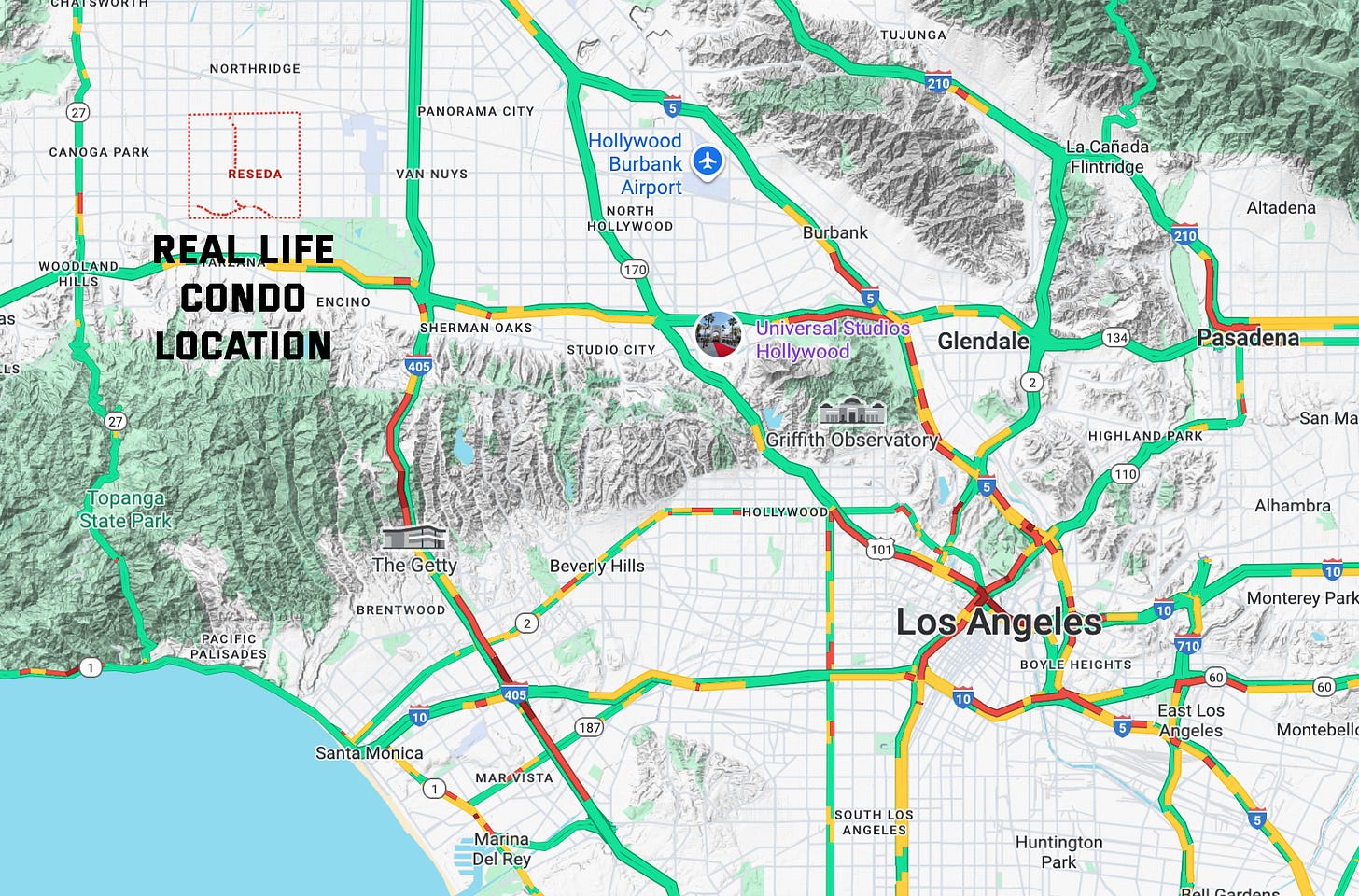What is Home Depot University?, The Office Townhouse Sells, & More
Around the College Towns: Links and commentary related to urbanism and higher ed for the week of Oct. 11 - Oct. 19.
Note: Around the College Town is my weekly links roundup article on urbanism and education. These posts mostly cover news that may have fallen through the cracks rather than the big events. Consider subscribing or donating to keep the research here running.
Home Depot University: Just Another MOOC
Home Depot recently announced their Path to Pros program. “The Skills Program is The Home Depot’s FREE, self-paced virtual training platform allowing you to discover career options in the Skilled Trades,” promises the website. It’s not quite Home Depot University, but the outlet is trying to train and educate the workforce with the initiative.
I do appreciate Home Depot for trying this and making it free. But I am here to temper some of the excitement. I am dubious that this Path to Pros program will make any real meaningful impact.
Home Depot’s Path to Pros is basically a MOOC for skilled trades. MOOCs, aka massive open online courses, were a huge deal in education in the 2010s. There was a sense that Coursera, edX, and the like were going to replace traditional brick-and-mortar higher ed. That didn’t happen, as these traditional institutions just ended up making their own online programs (this is part of the Age of Conquest in higher ed story).
Despite my question marks, there is still a lot of buzz around the initiative. BehizyTweets, a massive X account with over 600K followers, had enthusiastic praise for the new educational service. “THIS IS AWESOME!,” he exclaimed in a post that received 2.7M views. Others went to Reddit to voice their curiosity about the program.
I just am not buying this type of online program is going to teach students the skills they need to really work in these fields. Home Depot promises these “self-paced” courses “can be completed in very little time.” But there are no real teachers and only “knowledge checks.” As any teacher knows today, this sounds ripe for cheating with AI.
Furthermore, despite the perception that skilled trades are for students with lower intellectual aptitudes, the reality is that these systems and processes can be quite complicated. These are not things students should rush through.
Students in the trades need hands-on training, they need mentors watching how they work, they need peers to help motivate and acclimate to the job. The trades are best taught through real apprenticeships, not through online MOOCs. If you don’t believe me, an egg head professor sitting in his Ivory Tower, consider the view from people working in the trades.
A version of Home Depot’s program has been running for a couple of years (I am actually unsure how the old version is different from what was announced this week). The electricians over on the r/electricians Subreddit did not think much of it. A Home Depot training is not going to get you anywhere with a serious contractor, said the most upvoted comment. “Getting into an apprenticeship is not only free to you, you also get paid to work while you learn the trade. Finding unconventional routes isn’t a great idea.”
Users on r/hvacadvice were also dubious. “No such thing as basic HVAC repairs,” said one commenter. Another added, “My experience is that you get what you pay for and ‘free’ classes are often just product push to try to get you to use whoever’s stuff that is hosting the class.” People in these fields seem to agree that these online videos will not turn you into Ron Swanson.
Apparently, Home Depot’s stock price took a dip with the announcement. So even investors do not seem to believe the initiative will be transformative for the sector. It is a shame because we need more people in the skilled trades. I will have a future article on this issue.
In the end, I think these online programs would best be suited for hobbyists or novices first trying out home renovations. Someone like me and my wife actually! Perhaps, we will try them out and report back on their efficacy.
These kinds of online programs are simply not suitable replacements for traditional pathways into the skilled trades. Potential students interested in these fields should look into local community colleges, vocational schools, or endeavors like Texas A&M University–Kingsville’s new academy. Home Depot U is not the answer.
Links I’m Reading This Week
Education
Mr. Beast and East Carolina University established a partnership to create academic programs in 2022. How are they doing now? They don’t exist yet. Very typical story of higher ed.
Gavin Newsom signs several laws that make it easier for California colleges to build housing.
There was a massive drop in data usage after Finnish schools banned phones. Kids are really using phones. I will be interested in seeing what the academic and social outcomes are from the bans.
Philly community college launches partnership with Welsh university. Funny enough, it’s with Wrexham University, where the local soccer team is co-owned by Philly native Rob McElhenney.
Architecture and design magazine cites universities that have “architectural masterpieces” on campus. They are all, of course, modern buildings, so they don’t align with my taste. In my view, every Old Main by a no-name architect is better than anything cited here.
Two Nobel Prize winners from MIT flee to Germany due to Trump’s recent attacks on higher ed. I’m not going to make the comparison. I’m not going to do it. You cannot make me do it. It’s too cliche. But you are probably thinking it already.
Urbanism-ish
An idea from over a century ago to connect the coasts of Mexico finally comes to fruition. They hope the line can compete with the Panama Canal. Cool photo essay, too.
New video game lets players battle over who can best operate the New York City subway system, entitled Metro Rivals: New York.
Tehran, Iran, opens a new metro station named after the Virgin Mary. Iran always seems to have something interesting happening in terms of urbanism.
Waymo’s may actually not work in the US due to our culture of irresponsibility.
The hippies in the Bay Area just ended up becoming NIMBYs. Emblematic story of building in California from Fairfax, a town north of San Francisco. Reddit users had a lot of criticism for these people.
Chatbots and AI are quickly replacing human traffic to Wikipedia. Dead internet theory in action.
A London-based tech journalist doesn’t think Waymo will work in his city. His reasoning was pretty basic (mostly about price and time waiting). I want to see some real argument here.
Around Substack
Note: I also think it’s important to stay connected to the growing Substack community. Here are a few I am reading this week:
, who runs the , has a breakdown of the problems with California rail. This passage in particular highlights the frustration of why we don’t can’t build trains here:The gridlock worsened from California’s own regulatory infrastructure. The California Environmental Quality Act, has become one of the project’s most formidable adversaries. In Town of Atherton v. California High-Speed Rail Authority (2014), affluent Bay Area municipalities challenged the environmental review for the Peninsula corridor. The court’s ruling, while allowing construction to proceed, confirmed that even state-owned climate infrastructure must run the full CEQA gauntlet. The high-speed rail has faced dozens of such challenges—from Central Valley farmers worried about bisected farmland to Peninsula cities concerned about noise, from developers protecting planned communities to hospitals and churches demanding route changes.
Then, every day, a new road, parking lot, highway, or any other car infrastructure just keeps on dominating our beautiful landscape. Frustrating.
was commenting on a comment from on micropayments brought up by . Basically, there is debate over whether Substack should allow people to sell one article at a time, aka micropayments. A lot of writers here are against it.Tarpit ideas are business ideas that appear promising and obvious but are incredibly difficult to execute and have been tried over and over again but have failed over and over again.
I have never heard this term. It is quite useful, and can be expanded into education (perhaps connecting back to MOOCs) and urbanism. I may have to use it in future articles.
Closing Time… The Office Townhouse
A famous TV house just sold recently: Michael Scott’s condo from The Office. The condo is a running joke throughout the series, starting when Michael first bought it in the second season’s Office Olympics. The joke is that the place is supposed to be kind of dumpy. The condo is also the setting for one of the greatest episodes in sitcom history: Dinner Party.
The real home is 1458 sq ft, with 3 bedrooms and 3 baths located in Reseda, California. It just sold for $710,000, which is either expensive or cheap depending on where you live. If this were in Scranton, PA, that price would likely be well outside the range of a regional manager of a midsized paper company.
In the Los Angeles metroplex, anything under a million is a deal. Although Reseda is pretty far out there and nowhere near the beach. But, hey, the Burbank Airport is supposed to be much better than LAX. Plus, you could own a little bit of TV history.






The stock dip makes sense when you realize investors probaly see this as marketing spending rather than workforce development. Home Depot benefits even if these programs dont produce actual professionals because DIY hobbyists who take the courses become more confident customers buying more tools and materials. The real value for HD isnt in creating competitors for professional contractors but in expanding their customer base of amateur renovators who think they can handle bigger projects. This is basically customer acquisition disguised as philanthropy, and the trades community sees right through it.
The general idea that massive online education will displace traditional educational methods is a fantasy that we can deliver similar outcomes with much less effort.
To use an example from my local area, Seattle Central College has a Wood Technology Center that trains people in boat building and construction carpentry.
They also have a continuing education division that teaches a series of woodworking classes.
The facility has a lot of equipment (the woodshop has at least a dozen Saw Stop Cabinet making saws.
The instructors have to teach the students to use the equipment safely.
This is a large investment of equipment, real estate, and people, and while it is a fantastic program, it is ultimately limited in how many people can go through it.
Skilled trades, like any skill require time, and instruction to get through, and watching an online lecture on the theoretical and academic parts of a trade might offer some savings, it’s not really the bottleneck in training more people for the trades.
A better intervention would be offering more general training in high-schools, so that students can enter trade school and apprenticeship programs more competent in the basics they’ll need to know.
But that also has a problem. In the middle of the last century, finding qualified shop teachers was fairly easy, those skills were more saturated through society. They’re now much more limited and the people who have them don’t fit the mold we have in mind for teachers.
It might be worth considering having a program for tradespeople who had to retire early due to injury or disability to teach shop classes part time, but that would also involve investing in putting shop facilities back in schools.